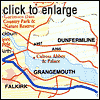|
East of Stirling
FALKIRK, STIRLING & THE TROSSACHS
From Kinross and Tayside the A91 - A977 enters the eastern
aspect of this region. Two intriguing names appear on local signposts, the "Rumbling
Bridge" and the "Yetts o' Muckhart.' 'Yetts' means gates and applies to
the entrance to the "Hillfoots", a long string of medium-sized elevations
otherwise known as the Ochils.
The Rumbling Bridge is signposted on the A823 south
of the Yetts o' Muckhart or only a few yards north off the alternate A91. The road
passes unhindered over this nineteenth century bridge contradicting the might work
of nature below. There is an official Gorge Car Park next to the Rumbling Bridge
Nursing Home, otherwise parking on or near the road is rather dangerous.

From the Ice Age and subsequent 10,000 years, fast
flowing water has carved a deep, dark gorge in the basalt rock creating an impressive
cleft with fern-fringed cascades and deep, dark pools. There are paths and wooden
stairs leading to well-constructed viewpoints. A deep pot called the Devil's Mill
is where the crashing of the water onto boulders makes an eerie reverberation, much
like the sound of an old, working textile mill. To the chagrin of the staunch church-goers
of the area, it refused to stop, even on a Sunday - hence its name.
The area between the Yetts o' Muckhart and the east side of
Stirling is the Clackmannan District or the 'Wee County'. This quiet backwater was
once alive with the sounds of industry when the 'Hillfoots' were a thriving manufacturing
base for the textile trade of the eighteenth and nineteenth centuries. The lush slopes
of the Ochils supplied grazing for sheep, in turn supplying the fabric, while rivers
pouring off the hills, became a source of power for the mills that sprang up in the
area. By the mid-1800s they had created a busy woollen and tartan manufacturing trade
rivalling that of the Scottish Borders.
Dollar
Because of its reputation as a seat of learning, the
town fathers of Dollar discouraged the development of the mill industries, which
allowed the town to take on a more genteel air, still palpable today. It is best
known for its nineteenth century academy, made possible by John McNabb, a local lad
who made a fortune in shipping in London and returned to share his wealth with his
home community.
Dollar Golf Club is set at the back of town and appears
to have no golf course attached to it unless you look above the clubhouse to see
the 18th green and 1st tee which gives an indication how hilly this course can be.
The road to the right of the river leads to Dollar
Glen and Castle Campbell. The glen is a wild, tangled ravine that the waters of the
River Devon have deepened through thousands of years.
There are three options on how to approach the glen
and castle. One is to leave your car in the village and walk up East Bankside and
on through the glen, taking around three hours round trip including a stop at the
castle for refreshments. Alternatively, you can drive to a car park half way up that
still offers a good walk through the glen or up the steep road leading to the castle.
Either way is most scenic. Finally, you can drive to a small car park higher up and
avoiding the glen altogether.
If you are averse to walking at all, there are still
some steep hills to be negotiated to the castle. The walk through the glen covers
some very rough paths so adequate footwear is necessary. It has been made safer and
more accessible with the introduction of stout wooden bridges built by the men of
the 75th Engineer Regiment.
At the head of the glen, surveying all below it, is
Castle Campbell. The castle dates back to the fifteenth century though an earlier
fortress did exist on this site. The Campbells of Argyll changed its name from Castle
Gloom in 1489 when it was passed to them through marriage. The Campbell family was
staunch Presbyterian and invited John Knox here to preach on the knoll now known
as Knox's Pulpit. From the castle roof there are excellent views over the village
of Dollar to the Forth Valley and beyond. Behind the Castle is the King's Seat, a
very popular hill-walking area.
The road to Stirling
 The next town to the west is Tillicoultry, the largest of
the 'Hillfoot' communities and, at one time, supporting eighteen textile mills. Its
Clock Mill Heritage Centre is at the heart of the Mill Heritage Trail. The story
of weaving and woollens is illustrated here with displays of equipment, audio-visual
programmes and workshops. This former mill building, dating from 1624 also houses
the local tourist information centre. The next town to the west is Tillicoultry, the largest of
the 'Hillfoot' communities and, at one time, supporting eighteen textile mills. Its
Clock Mill Heritage Centre is at the heart of the Mill Heritage Trail. The story
of weaving and woollens is illustrated here with displays of equipment, audio-visual
programmes and workshops. This former mill building, dating from 1624 also houses
the local tourist information centre.
Carrying on west towards Stirling and behind the town
of Alva, there is the romantically named Silver Glen where indications of the silver
mines that operated here dating from the seventeenth century are still evident. There
is also a complex system of water channels and weirs on the lower slopes of the hill
that were once used to power the textile mills of Alva. From here it is relatively
easy to scale the Ochils' highest peak, Ben Cleuch at 2,363ft (721m), a hike well
rewarded with views over much of Central Scotland.
Closer to the north banks of the River Forth, Alloa
does not present itself much as a tourist stop having a long tradition as an industrial
town with coal mining, textiles production and glass-making but there are several
key points that may bear further investigation.
The Erskines of Mar, the hereditary keepers of the
royal castle of Stirling and one of Scotland's most influential families, made their
home here and their fourteenth century tower, recently restored, can be visited.
Gartmorn Dam Country Park and Nature Reserve is found
near Sauchie. The dam and reservoir were originally created as a source of power
for the many textile mills in the area. There is a visitor centre where rangers commence
guided walks of the park. Alloa is still dependent on water for their brewing industries
as it is still one of the largest brewing centres in Scotland.
If you wish to explore the southern banks of the Forth,
which, although now fairly dedicated to the petro-chemical industry, has several
gems worth seeing, then take the A907 from Alloa towards the Kincardine Bridge.
|


